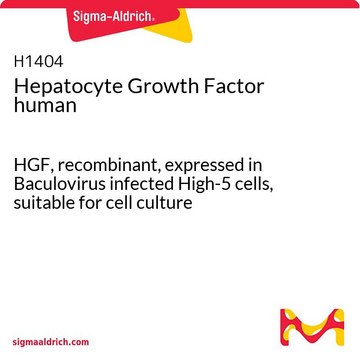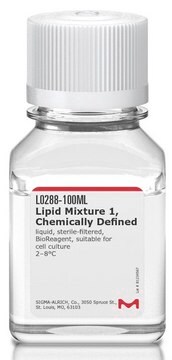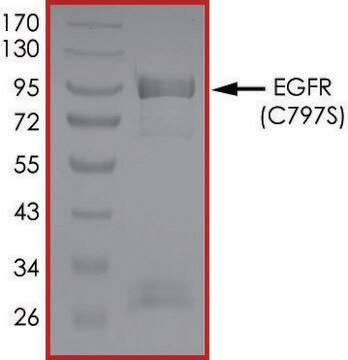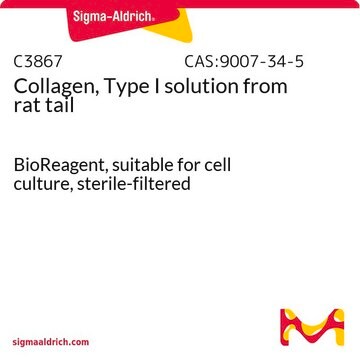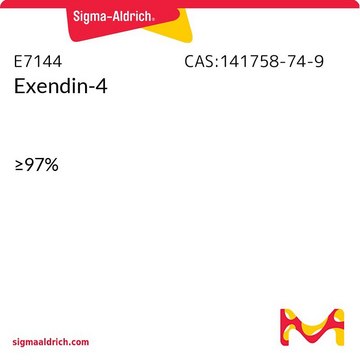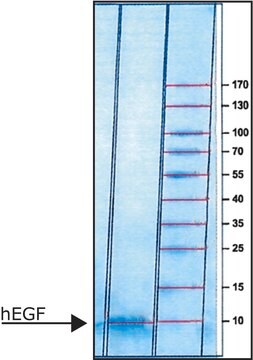おすすめの製品
製品名
肝細胞増殖因子 ヒト, HGF, recombinant, expressed in HEK 293 cells, HumanKine®, suitable for cell culture
由来生物
human
品質水準
リコンビナント
expressed in HEK 293 cells
アッセイ
≥95% (SDS-PAGE)
フォーム
lyophilized powder
有効性
≤20 ng/mL EC50
品質
endotoxin tested
分子量
monomer 70 kDa (glycosylated)
包装
pkg of 5x10 μg
pkg of 10 μg
保管条件
avoid repeated freeze/thaw cycles
テクニック
cell culture | mammalian: suitable
不純物
≤1 EU/mg
UniProtアクセッション番号
保管温度
−20°C
遺伝子情報
human ... HGF(3082)
類似した製品をお探しですか? 訪問 製品比較ガイド
詳細
肝細胞増殖因子遺伝子の長さは約70 kbで、17個のイントロンが含まれる18個のエキソンからなります。ヒトHGF遺伝子の構成は、ヒトプラスミノーゲン遺伝子と高い相同性を示します。HGFは、ヒト7番染色体長腕(7q21.1)にマッピングされています。
生物化学的/生理学的作用
肝細胞増殖因子(HGF)は、有糸分裂誘発 細胞遊走、細胞浸潤、形態形成を促進する多機能性サイトカインです。肝細胞増殖因子は、肝細胞、尿細管上皮細胞、表皮ケラチノサイト、表皮メラニン細胞、Mv1Lu(ミンク肺上皮細胞)、BALB/MK(マウスケラチノサイト)の増殖を刺激する強力なマイトジェンです。HGFはB6/F1(マウスメラノーマ)細胞、KB(ヒト扁平上皮癌)細胞、HepG2(ヒト肝細胞癌)細胞の増殖を阻害します。HGFは、がん原遺伝子metによってコードされるチロシンキナーゼ受容体のリガンドです。
肝細胞増殖因子(HGF)は、肝細胞、ならびに内皮細胞、上皮細胞、メラノサイト、およびケラチノサイトを含む様々な細胞タイプにおける強力な分裂促進因子です。また、上皮形態形成にも関与します。HGFは、met癌原遺伝子によってエンコードされるチロシンキナーゼ受容体のリガンドです。
その他情報
NSO細胞で発現させた組み換えHGFは、95%以上がヘテロ2量体型HGFです。昆虫細胞株で発現させた組み換えHGFは、1本鎖HGF(主成分)とヘテロ二量体型HGFの混合物です。1本鎖HGFとヘテロ二量体型HGFは、in vitroアッセイで同等の活性を示します。
物理的形状
Lyophilized from a 0.2 μm filtered solution of 1x PBS.
調製ノート
HumanKine HGFは、ヒトHEK293細胞で、グリコシル化された70 kDaの一本鎖単量体として発現します。ヒトHEK293細胞で産生した場合、正しくグリコシル化が行われます。グリコシル化により、細胞増殖培地やその他用途での安定性が得られます。
アナリシスノート
特異的活性は、サル上皮細胞株4MBr-5の増殖の用量依存的な刺激作用によって確認されました。
法的情報
HumanKine is a registered trademark of Proteintech Group, Inc. and Humanzyme, Inc
保管分類コード
11 - Combustible Solids
WGK
WGK 3
引火点(°F)
Not applicable
引火点(℃)
Not applicable
適用法令
試験研究用途を考慮した関連法令を主に挙げております。化学物質以外については、一部の情報のみ提供しています。 製品を安全かつ合法的に使用することは、使用者の義務です。最新情報により修正される場合があります。WEBの反映には時間を要することがあるため、適宜SDSをご参照ください。
Jan Code
H5791-10UG-PW:
H5791-BULK:
H5791-5UG:
H5791-5X10UG:
H5791-VAR:
H5791-10UG:
この製品を見ている人はこちらもチェック
Karène Mahtouk et al.
Biochimica et biophysica acta, 1806(2), 208-219 (2010-07-27)
Hepatocyte growth factor (HGF) and its receptor MET are essential during embryonic development and throughout postnatal life. However, aberrant MET activation, due to overexpression, mutations, or autocrine ligand production, contributes to the development and progression of a variety of human
T Nakamura et al.
Nature, 342(6248), 440-443 (1989-11-23)
Hepatocyte growth factor (HGF) is the most potent mitogen for mature parenchymal hepatocytes in primary culture, and seems to be a hepatotrophic factor that acts as a trigger for liver regeneration after partial hepatectomy and liver injury. The partial purification
MET and PI3K/mTOR as a potential combinatorial therapeutic target in malignant pleural mesothelioma.
Rajani Kanteti et al.
PloS one, 9(9), e105919-e105919 (2014-09-16)
Malignant pleural mesothelioma (MPM) is an aggressive disease with a poor prognosis. Studies have shown that both MET and its key downstream intracellular signaling partners, PI3K and mTOR, are overexpressed in MPM. Here we determined the combinatorial therapeutic efficacy of
Hiroshi Kusunoki et al.
Hypertension research : official journal of the Japanese Society of Hypertension, 37(6), 500-506 (2014-03-14)
The paracrine loop involving inflammatory cytokines between adipocytes and macrophages establishes a vicious cycle that aggravates pro-inflammatory changes in adipose tissue. The serum level of hepatocyte growth factor (HGF) is increased in metabolic syndrome, but whether HGF is beneficial or
Lanfang Meng et al.
Cancer biology & therapy, 15(6), 721-734 (2014-03-13)
The anaplastic lymphoma kinase (ALK) and the c-Met receptor tyrosine kinase play essential roles in the pathogenesis in multiple human cancers and present emerging targets for cancer treatment. Here, we describe CM-118, a novel lead compound displaying low nanomolar biochemical
ライフサイエンス、有機合成、材料科学、クロマトグラフィー、分析など、あらゆる分野の研究に経験のあるメンバーがおります。.
製品に関するお問い合わせはこちら(テクニカルサービス)